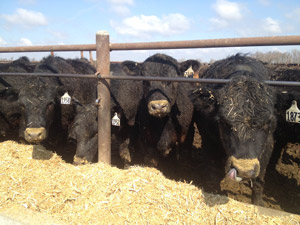Methane emissions from manure
Part 2: Source and amount of methane emissions
June 2014
 The majority of research on methane produced from manure has been in confined systems where manure is collected on concrete. Less research is available evaluating methane emissions from manure in open lot production or on pasture.
The majority of research on methane produced from manure has been in confined systems where manure is collected on concrete. Less research is available evaluating methane emissions from manure in open lot production or on pasture.
The majority of the focus of the research has been on nitrous oxide (N2O) from manure instead of methane (CH4) due to its greater potency as a greenhouse gas, and importance in manure management. However, whenever anaerobic conditions exist (lack of oxygen) and substrates and environment are suitable for microbial fermentation, methane production will occur. Our focus will be on methane production from beef cattle manure. Microbial processes occur at all stages of manure management that include housing/accumulation, stockpiling, and after land application. An excellent review of literature is available on this topic across species with a focus on both N2O and CH4 (Chadwick et al., 2011).
Losses of methane from manure storage have been documented at 0.4 to 9.7% of the carbon content (Chadwick, 2005). Carbon is approximately 49% of organic matter which is commonly measured in manure. Stockpiling manure creates an anaerobic environment which aids conversion of some of the organic matter to methane. Aerobic composting will decrease methane production and loss, but increases N losses as both nitrous oxide and ammonia.
Temperature is also an important factor influencing methane losses. When temperatures are below 60 degrees F, methane losses are relatively low but increase exponentially with increasing temperature above that threshold (Clemens et al., 2006; Sommer et al., 2007).
Few mitigation strategies
Few mitigation strategies are possible or feasible. One option is to digest manure using methane digesters to purposely produce methane from manure and capture the resulting biogas for energy consumption. Once digested, the resulting digestate produces much less methane. Emissions were reduced by 30 to 66% for digested manure compared to untreated manure handled similarly (Clemens et al., 2006; Amon et al., 2006).
Once manure is land applied, methane emissions are short-lived and peak immediately after land application likely due to exposure to wind and air. The release of methane after field application is likely originating from methane already produced in the manure during storage. Once field applied, oxygen exposure inhibits further methane production from manure on the soil surface. An exception to this would be field application of slurry that is injected, which results in greater methane than surface application.
Most of the techniques or practices that inhibit methane production result in increases in oxygenation and subsequent production of nitrous oxide (more potent than methane) and also increase ammonia losses or potential. Few strategies are available that can be readily adopted that will decrease methane without other negative consequences. The only exception may be anaerobic digestion of manure and capture of methane for further uses as an energy source.
Galen Erickson
Professor
Animal Science
University of Nebraska–Lincoln
References
- Chadwick, D., S. Sommer, R. Thorman, D. Fangueiro, L. Cardenas, B. Amon, and T. Misselbrook. 2011. Manure management: Implications for greenhouse gas emissions. Anim. Feed Sci. Tech. 166-167:514-531.
- Amon, B., V. Kryvoruchko,M. T. Amon, and S. Zechmeister-Beltenstern. 2006. Methane, nitrous oxide, and ammonia emissions during storage and after application of dairy cattle slurry and influence of slurry treatment. Agric. Ecosyst. Environ. 112:153-162.
- Chadwick, D. 2005. Emissions of ammonia, nitrous oxide, and methane from cattle manure heaps: Effect of compaction and covering. Atmos. Environ. 39:787-799.
- Clemens, J., M. Trimborn, P. Weiland, and B. Amon. 2006. Mitigation of greenhouse gas emissions by anaerobic digestion of cattle slurry. Agric. Ecosyst. Environ. 112:171-177.
- Sommer, S. G., S. O. Peterson, P. Sorensen, H. D. Poulsen, and H. B. Moller. 2007. Methane and carbon dioxide emissions and nitrogen turnover during liquid manure storage. Nutr. Cycling Agroecosyst. 78:27-36.